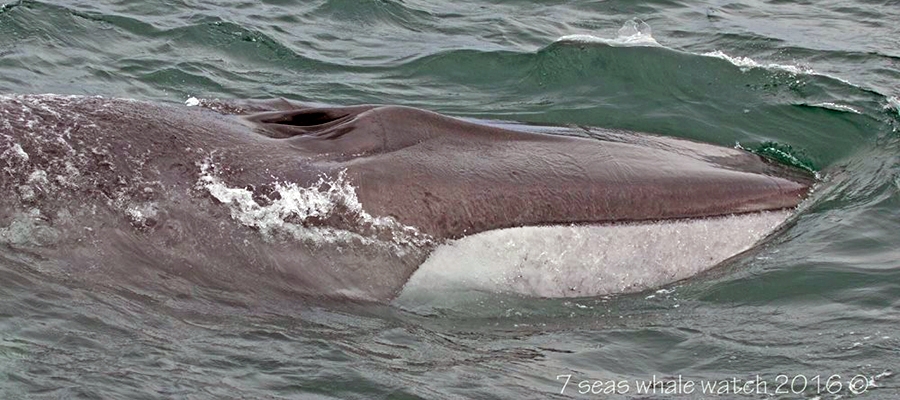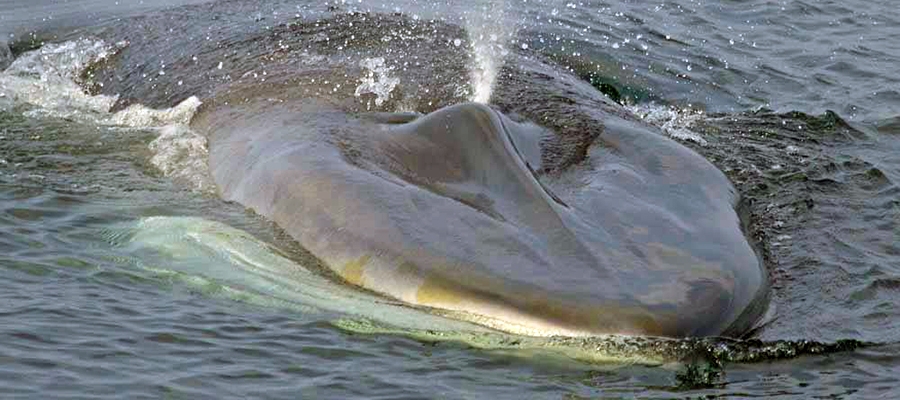Finback Whale
(Balaenoptera physalus)
While Humpback Whales are usually the main focus of our whale watching trips, there is another species which, in many people’s opinion, is equally as spectacular though perhaps in a more sublime way… the elegant Finback Whale.
Finback (or simply “Fin”) Whales are giants even amongst whales. Adult Finback Whales reach lengths of 89 feet, easily making them the second largest animal on the planet (only the Blue Whale is larger). In fact many of the Finback Whales in our population are double the length of most of the Humpback Whales in the area. However the sleek design, fast speed, and elusive nature of the Finback Whale makes these “greyhounds-of-the-sea” as they’re called a more difficult to animal to get a close look at than the relatively slow-moving Humpback Whales.
When you manage a close look at a Finback Whale (which usually requires some hard work, some patience, some luck, or a combination of those factors!) you will undoubtedly be struck not just by the sheer size of the animal, but also by its subtle yet intricate color patterning. Fin Whales (again, you can call them either “Finback” or simply “Fin” whales) are much lighter gray overall than the Humpback Whale is. However if you look close you will see a swirling pattern consisting of different shades of gray over the entire length of the animal (except for its belly which is pure white). In particular you may notice two very light bands on the animal. One of these bands is relatively short and goes from just behind the animal’s eye and sweeps up towards the blowholes. This light band is called the “blaze”. The second light band goes from just behind the eye once again but then sweeps down the back of the animal towards the “shoulder” and then runs up over the animals back. This longer light band is called the “chevron”. Every fin whale has this “blaze and chevron” pattern, however it is much brighter in some individuals than in others. One of the most unusual attributes of the Fin whale is its “asymmetrical” coloration. The right side of the Fin whale is much lighter than the left. Some Fin Whales can even be pure white along their upper lip and lower jaws on the right side. The left side is entirely dark gray.
The “blaze-and-chevron” pattern described above is also asymmetrical: although you can see this pattern on both sides of the Fin Whale’s body, it is much brighter and more prominent on the right side than on the left. Many researchers have theorized that this asymmetrical coloration may be a feeding adaptation. When Fin Whales feed they are often seen lunging on their right sides to catch prey (see photo at right). By keeping the right jaw (the lighter jaw) pointed into the water and towards the fish the whale may be able to concentrate prey for more efficient feeding (just as Humpbacks do with bubble clouds). Finback Whales are not nearly as well understood as Humpback Whales are. Whereas the Humpback Whales are easily recognizable as individuals by the pattern of black-and-white pigmentation on the under-side of their tail flukes, Fin Whales have no such easily recognizable marking by which researchers could separate one Fin Whale from another. Slight variations in dorsal fin shape and size, as well as other subtle clues can help separate individual Fin Whales, but these non-descript variations are difficult (if not impossible) to discern at sea. As a result the Finback is one of the most poorly understood whales in the world. In fact, we don’t even know where these whales go to breed! Each Fall the entire Finback population of the southern Gulf of Maine simply disappears. We know that the Humpback Whales that feed in our area each Summer and migrate to the Caribbean because photos taken of the tails of Humpback Whales here in New England during the Summer clearly match those taken by researchers in the Caribbean during the Winter. But where the Finbacks go to breed is still a mystery.
We can assume that they seek out warmer waters in which to give birth… just like the Humpbacks. But which warmer waters? If they congregated somewhere close to shore we would have probably found them by now. Perhaps they head far off shore each winter. Even as far north as Gloucester, if you head far enough out to sea (about 250 miles) you will encounter the warm waters of the “Gulf Stream”. The Gulf Stream is a warm water current (actually part of the “Global Conveyor Belt” of water that circulates ocean water all around the globe) that flows through the Caribbean Sea and then along the southeast coast of the U.S. At about Cape Hatteras, North Carolina, the Gulf Stream turns eastward and crosses the Atlantic, eventually bathing the United Kingdom in its warm water (that’s why the British can swim in the sea at the same latitude that Canada has Polar Bears). There is some evidence that Fin Whales may visit these distant, off-shore waters in the winter to breed which would explain their apparent disappearance. It is incredible to think that the second largest animal on the planet has the ability to all but vanish for half of each year. Despite the fact that whales are huge creatures, compared to the vastness of their ocean environment they are still proverbial needles in a giant blue haystack. Telling apart Fin Whales and Humpback Whales is easy when the whale happens to be close to the boat. From a great distance it away, however, it is not always a simple identification to make and I still get fooled after 21 years on the water! Both species are very common, very large, and feed in similar areas (often on the same prey).
So if you should see a spout in the distance how would you recognize it as a Fin Whale or a Humpback? Often times the shape of the spout is your best clue. The “blow” or “spout” produced when a Humpback surfaces to breath is generally low and bushy-shaped. The Fin Whale blow, by comparison, is taller (~20 feet tall as compared to the humpbacks 10 to 15 feet) and much columnar. High winds, however, can distort the shape of the spout very quickly so spout shape is most useful on calm and wind-less days at sea.



